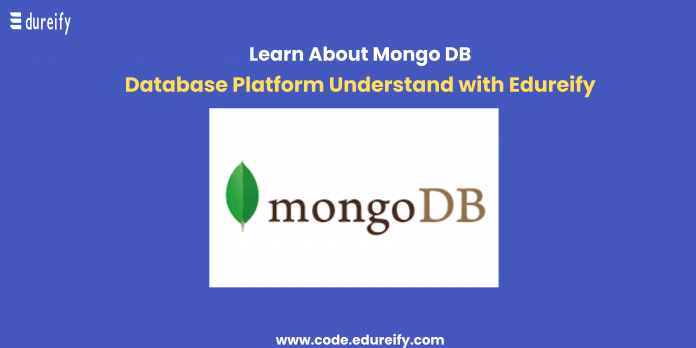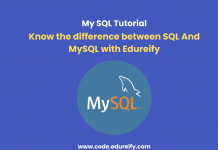In today’s data-driven, the need for structured database management systems is a must for efficient application development. Database management systems are in demand and use. With the growing need for database management systems, there is an equal rise in the various database management system applications. One such important database management system is MongoDB.
Edureify, the best AI Learning App has previously talked about MySQL, another very popular database management system. Edureify’s coding courses also provide necessary information on SQL, MySQL, and other necessary and important programming languages and tools.
In this article, Edureify will talk about the features and applications of MongoDB, another very popular database management system.
What is MongoDB?
MongoDB was launched on August 27th, 2009. It is a popular NoSQL database management system. NoSQL databases like MongoDB store unstructured and schema-less data in various collections and nodes. It is a non-relational database, i.e., it does not require fixed table sachems. The NoSQL database like MongoDB is placed horizontally and supports a few join queries.
Some of the characteristics of MongoDB are-
- It is open-source
- Is scalable
- It is a NoSQL database that is free to use
- Has a commercial version
- It is very versatile
- It is flexible according to needs
- Used for backend data storage in highly professional organizations like Facebook, Twitter, Google, Forbes, and more
Why use MongoDB?
The following are some prominent reasons why MongoDB is used in high-profile organizations and other places-
- Versatile– MongoDB can comprehend various programming languages enabling it to be easily implemented and maintained. It is also very expressive because it can store documents that further contain sub-documents that are in a complex hierarchy.
- Workable Query Model– User can mark important parts of a document or query based on its use and need.
- Native Aggregation– This feature allows the user to extract and change the data from the database. The data can further be formed into a new format or taken to other data sources.
- A model that is Schema-Less– The different properties that are found in a document collection can be interpreted accordingly by the applications.
Benefits of using MongoDB
The benefits of using MongoDB are as follows-
- Being a NoSQL database, it is cheaper and easier to use. It can be used for easier data distribution, has a simple data model, and can repair automatically.
- It is open-source, therefore, has a very less server cost.
- Can be scaled easily.
- It has integrated caching that generates data output performance.
- Has zero schema problems.
- It is user-friendly that has features like-
- Aggregations
- Capped collection
- Ad-hoc queries
- Server-side JavaScript execution, and more
Places to use MongoDB
MongoDB is a NoSQL database, i.e., it has a higher functioning rate with unstructured data. Big Data systems, social networking platforms, news sites, MapReduce applications, and the likes.
Some of the best places to use MongoDB are-
- For Cloud Computing. Cloud-based storage requires easy distribution of data across various servers, a feature that is prominent in MongoDB.
- For fast and easy accessibility of data. MongoDB is ideal for critical performance applications.
- When one does not have a database administrator for MongoDB is open source.
- Working with unstructured data.
- Applying Agile methodologies for development for MongoDB is a non-relational database that does not require a high-level of preparation.
- While facing schema issues.
Places to not use MongoDB
There are certain limitations to the use of MongoDB and the following are the places where one should not use MongoDB-
- When one is in need of ACID compliance, i.e., Atomicity, Consistency, Isolation, and Durability.
- While working on stored procedures.
- The data being used is structured and unchanging.
How does MongoDB work?
MongoDB is a database that contains collections. The collections further have multiple documents that might not to be similar to one another as MongoDB is schema-less. It uses key-value pairs to store data as BSON documents. The JSON data is then converted into the BSON format at the backend.
The data can be easily accessed with MongoDB for it can provision for nested data.
Applications of MongoDB
The following is a list where MongoDB is applied as an applications Database Management System-
- Mobile applications
- Content management
- Real time analysis
- Internet of things
- Personalization
- Catalogue management
Difference between MongoDB and MySQL
| Basis | MySQL | MongoDB |
| Priority | Engages in high data security | Is Cloud-friendly |
| Data Structure | It is structured | It is unstructured but can also have structured data that has the chances to grow fast |
| Data Representation | Tables and Rows | JSON documents |
| JOIN support | Yes | No |
| Query Language | Structured Query Language | JavaScript |
| Schema | Must be defined into columns and rows | Does not require definition |
| Productivity of Developer | Slow | Fast |
| Atomic Transactions | Supports atomic transactions, i.e., can support several operations within a transaction | Supports only multi-document transactions |
So here were the details regarding MongoDB.
Edureify provides coding courses that teaches students-
- JavaScript
- Structured Query Language
- Cloud Computing
- MySQL, and lot more
With Edureify’s coding courses students can further benefit-
- 200+ learning hours
- Attend live lectures
- Learn from the industry experts
- Get access to recorded lectures
- Have all doubts cleared instantly
- Get career guidance and job opportunities from Edureify’s job portal
With Edureify, students can learn more about Database Management Systems like MongoDB and MySQL along with other programming languages and tools. Study along with Edureify’s certified coding courses for more benefits.
Some FAQs on MongoDB-
1. What is MongoDB?
MongoDB is a popular NoSQL database management system. NoSQL databases like MongoDB store unstructured and schema-less data in various collections and nodes. It is a non-relational database, i.e., it does not require fixed table sachems.
2. When was MongoDB launched?
MongoDB was launched on August 2th, 2009.
3. Is MongoDB open source?
Yes, MongoDB is open source.
4. Mention some of the characteristics of MongoDB.
Some of the characteristics of MongoDB are-
- It is open-source
- Is scalable
- It is a NoSQL database that is free to use
- Has a commercial version
- It is very versatile
- It is flexible according to needs
- Used for backend data storage in highly professional organizations like Facebook, Twitter, Google, Forbes, and more
5. From where can I learn more about MongoDB and other Database Management Systems?
Take Edureify’s best online coding courses to learn more about MongoDB and other Database Management systems.
Master Your Coding Skills with BootSelf AI
If you're looking to enhance your coding abilities and upskill in artificial intelligence, look no further than the BootSelf AI app. This innovative platform provides AI-based coding lessons that are tailored to your individual learning pace.
Available on both iOS and Android, you can download the BootSelf AI app and start mastering coding skills today:








